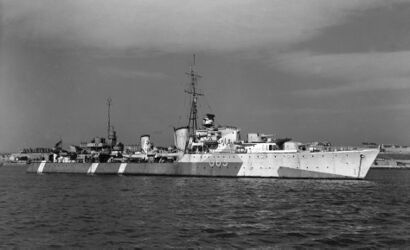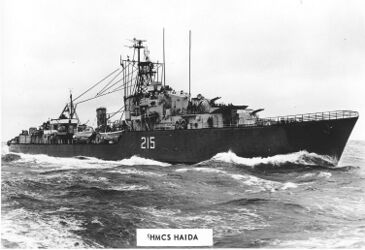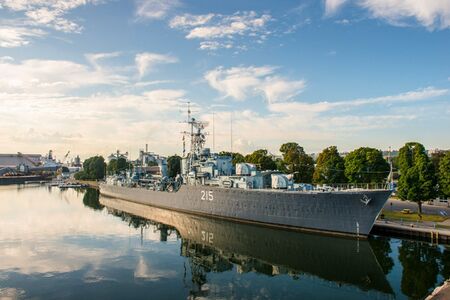User:SirDixie:eu/sandbox
HMCS Haida is a 'Tribal'-class destroyer that served in the Royal Canadian Navy (RCN) from 1943 to 1963, participating in World War II and the Korean War. She was named for the Haida people. After her service she was preserved as a museum.
The only surviving Tribal-class destroyer out of 27 vessels constructed for the RCN, the Royal Navy, and the Royal Australian Navy between 1937 and 1945, Haida sank more enemy surface tonnage than any other Canadian warship and as such is commonly referred to as the "Fightingest Ship in the Royal Canadian Navy".
Contents
Service History
1943
Haida entered service on 30 August 1943 and, under the command of Commodore Henry De Wolfe, joined the Royal Navy Home Fleet in October 1943.
At the end of 1943, Haida, together with her sister ships HMCS Huron and HMS Ashanti, participated in the escort of the Arctic convoys to the USSR. In November, Haida was part of the cover for the convoy JW-54A , which left Loch Ewe, Scotland. From 28 November, Haida escorted the return convoy RA-54B , which arrived at Loch Ewe on 9 December. On December 20, convoy JW-55B left for the USSR , the escort included Haida. The German battleship Scharnhorst tried to attack the convoy , but was sunk by British forces in the Battle of the North Cape, Haida did not participate in the battle. She also escorted the return convoy RA-55B , which left the Kola Bay on 31 December and arrived in Britain on 8 January 1944.
1944
On January 10, 1944, she was transferred to Plymouth Command for operations against the German fleet in the English Channel as part of the build up to D-Day. Haida joined the 10th Destroyer Flotilla under the command of Basil Jones. The ships of the flotilla went out into The Channel, often at night, to fight with torpedo boats and enemy transports, covered coastal convoys, mine laying and minesweeping . By April, Haida had participated in 19 such operations.
On the night of April 26, 1944, Haida took part in the battle off Les Settes-Iles, where a British light cruiser and 4 Tribal-class destroyers intercepted 3 German destroyers as they were returning from minelaying. During the battle, Haida, together with other destroyers, sank the destroyer T-29 with artillery fire , the other two managed to escape. This was the first destroyer sunk by an RCN ship during World War II.
On the night of 29 April, Haida and Athabaskan again met the surviving destroyers in action off Ile-les-Bas. Athabaskan was torpedoed by T-24, which then managed to escape. Haida forced T-27 aground artillery fire and set about rescuing the crew of Athabaskan and rescued 48 survivors from the water.
During the Allied invasion of Normandy, Haida, as part of the 10th Flotilla, took part in the battle off the island of Ushant on 9th June, where 8 allied destroyers opposed 4 German destroyers of the 8th Destroyer Flotilla. HMS Tartar, HMS Ashanti, HMCS Haida and HMCS Huron, took the brunt of the encounter, shelling and sinking ZH-1 and heavily damaging Z-32. Subsequently, Haida and Huron pursued the two surviving ships, but were not successful as the German vessels sailed through a British minefield. On their return, they encountered the damaged Z-32 and pursued her until she was forced aground. Z-32 was later destroyed by Coastal Command Beaufighters.
After that, the active work of the 10th flotilla continued, now it was focused on the destruction of smaller German ships. On June 6, Haida and HMS Eskimo attacked the Type VIIC U-boat U-971 in the western English Channel with depth charges . She was damaged and surfaced, after which Haida fired on and sank her, the crew was picked up by destroyers.
On the night of 15 July , HMS Tartar, HMCS Haida and ORP Blyskawica sank the small submarine hunters UJ-1420 and UJ-1421 and one transport while raiding the harbor of Lorient, and set fire to two others.
August 5 Force 26 (light cruiser HMS Bellona, destroyers HMS Tartar, HMS Ashanti, HMCS Haida, HMCS Iroquois) covered minesweeping during Operation Kinetic. Around midnight, a German convoy was discovered north of the island of Ile de Ye: escort ship SG-3, minesweepers M-263 , M-486, patrol ship V-414 and coastal transport Otto. All ships in the convoy, except for SG-3 , were sunk. During the battle, a shell exploded in the rear turret, killing 2 people.
On 30-31 August, HMCS Haida and HMCS Iroquois escorted the French cruiser Jeanne d'Arc to Cherbourg. On September 22, HMCS Haida left Europe and arrived in Halifax, Canada on September 29, where she paid off for repairs and modernization.
1945
In early 1945, HMCS Haida returned to the European theater. In March, together with HMCS Iroquois, she covered escort aircraft carriers during a minelaying operation in the Granesund area (March 18) and a raid on Trondheim (March 24-28).
On 16 April, HMCS Haida, as part of the escort of convoy JW-66, left the Clyde for Vaenga, from where she escorted the return convoy from 2 to 6 May when she arrived at Scapa Flow. The destroyer began to prepare for the operation in Tronsheimsfjord, scheduled for May 17, but the war ended before the operation could take place. On May 29-31, HMCS Haida participated in the surrender of German submarines to the Allies at Bergen.
In June Haida returned to Canada, where she began preparations for participation in the war with Japan. However, before repairs and modernization were completed, World War II ended. On March 20, 1946, Haida was placed in reserve.
Post War
In May 1947, after refitting, Haida was returned to service and commissioned into the Canadian Atlantic Fleet. Over the following years, Haida participated in joint maneuvers and operations with the US and British navies. In the fall of 1948, Haida became the first Canadian Navy ship to visit Hudson Bay. On 4 June 1949, Haida and Nootka participated in assisting the aircraft carrier HMCS Magnificent, which ran aground off Port Mouton Island near Halifax. In November 1949, Haida rescued the crew of an American B-29 bomber which had ditched near Bermuda.
Korean War
After conversion to an escort destroyer in 1950-1951 under the new number DDE 215 , Haida was recommissioned into the fleet on March 15, 1952. The ship left Halifax on 27 September and after passing through the Panama Canal arrived in Sasebo, Japan on 6 November. On 18 November, Haida relieved Nootka on the west coast of the Korean Peninsula and operated on patrol until 29 November. From December 4, Haida patrolled the eastern coast of the peninsula, where, together with USS Moore, she shelled the railway depot at Songjin. On December 18-19, Haida fired on a train, but the locomotive managed to take cover in a tunnel.
On December 3, 1953, Haida returned to patrol and escorted aircraft carriers and made bombing missions in coastal areas. On 29 January, Haida destroyed a train north of Rivon. On 26 May , Haida destroyed a second train as well as a drifting mine. The destroyer left Sasebo on 12 June and returned to Halifax on 22 July via the Suez Canal.
Haida departed for her second trip to Korea on 14 December 1953 and arrived on 5 February 1954. Following the ceasefire agreement, the destroyer sailed home on 12 September and arrived on 1 December.
Final Years
In subsequent years, the destroyer took part in NATO operations in the North Atlantic and the West Indies. In May 1956, with Iroquois and Huron, she visited several ports along the St. Lawrence River.
Repairs took place in 1958-1959. In January 1960, she went to the West Indies, but due to breakdowns she returned on April 3 to Halifax. Constant breakdowns and hull cracks due to her advancing age meant the ship needed to undergo another refit.
Museum ship
By 1962 it was becoming obvious that Haida was nearing the end of her effective life. In 1963, Haida took part in publicity tours with a summer tour of the Great Lakes, this would be the final act of her service career. Former sailor Neil Bruce realized that Haida was likely destined for the breakers' yard and founded HAIDA Inc. with the aim of saving and preserving the ship.
On April 30, 1963, Haida was paid off for the last time and decommissioned from the fleet, in 1964 Haida was planned to be dismantled for metal. HAIDA Inc. managed to raise $20,000 and buy the ship back. She was transferred to Toronto, where she arrived on August 25, 1964, and was visited by many guests, including Vice Admiral De Wolfe, her first commander. The ship was restored, her first pennant number G63 was returned to her.
In the late 60s HAIDA Inc. was in financial difficulty and the ship was sold to the City of Toronto for $1. Until 2002, the ship was used as a museum and teaching aid for cadets. In 2002, the ship was purchased by the Canadian government and transferred to Halifax. She also received pennant number 215 again. In July 2006, HMCS Haida was twinned with another museum ship, ORP Blyskawica, with which she "served" together in the Royal Navy's 10th Destroyer Flotilla.
In February 2018, HMCS Haida became the flag bearer for the Royal Canadian Navy.
Battle Honours
Haida earned the following Battle Honours during her service: Arctic 1943-45 - English Channel 1944 - Normandy 1944 - Biscay 1944 - Korea 1952-3


